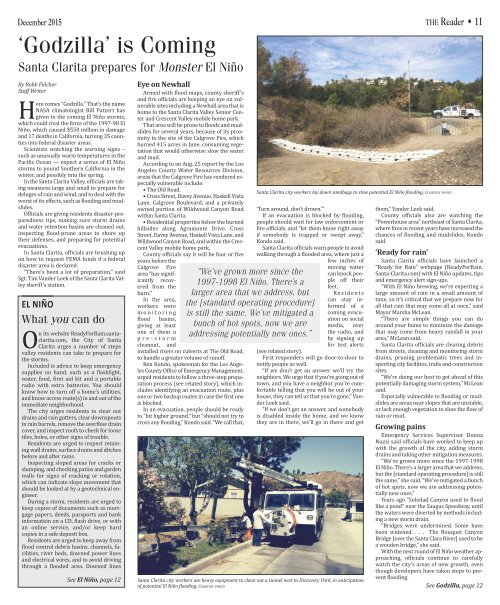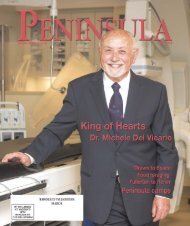You also want an ePaper? Increase the reach of your titles
YUMPU automatically turns print PDFs into web optimized ePapers that Google loves.
<strong>December</strong> <strong>2015</strong> THE <strong>Reader</strong> • 11<br />
‘Godzilla’ is Coming<br />
Santa Clarita prepares for Monster El Niño<br />
By Robb Fulcher<br />
Staff Writer<br />
Here comes “Godzilla.” That’s the name<br />
NASA climatologist Bill Patzert has<br />
given to the coming El Niño storms,<br />
which could rival the force of the 1997-98 El<br />
Niño, which caused $550 million in damage<br />
and 17 deaths in California, turning 35 counties<br />
into federal disaster areas.<br />
Scientists watching the warning signs –<br />
such as unusually warm temperatures in the<br />
Pacific Ocean — expect a series of El Niño<br />
storms to pound Southern California in the<br />
winter, and possibly into the spring.<br />
In the Santa Clarita Valley, officials are taking<br />
measures large and small to prepare for<br />
deluges of rain and wind, and to deal with the<br />
worst of its effects, such as flooding and mudslides.<br />
Officials are giving residents disaster-preparedness<br />
tips, making sure storm drains<br />
and water retention basins are cleaned out,<br />
inspecting flood-prone areas to shore up<br />
their defenses, and preparing for potential<br />
evacuations.<br />
In Santa Clarita, officials are brushing up<br />
on how to request FEMA funds if a federal<br />
disaster area is declared.<br />
“There’s been a lot of preparation,” said<br />
Sgt. Tim Vander Leek of the Santa Clarita Valley<br />
sheriff’s station.<br />
el niño<br />
What you can do<br />
On its website ReadyForRain.santaclarita.com,<br />
the City of Santa<br />
Clarita urges a number of steps<br />
valley residents can take to prepare for<br />
the storms.<br />
Included is advice to keep emergency<br />
supplies on hand, such as a flashlight,<br />
water, food, first aid kit and a portable<br />
radio with extra batteries. You should<br />
know how to turn off a home’s utilities,<br />
and know access route(s) in and out of the<br />
immediate neighborhood.<br />
The city urges residents to clear out<br />
drains and rain gutters, clear downspouts<br />
in rain barrels, remove the overflow drain<br />
cover, and inspect roofs to check for loose<br />
tiles, holes, or other signs of trouble.<br />
Residents are urged to inspect retaining<br />
wall drains, surface drains and ditches<br />
before and after rains.<br />
Inspecting sloped areas for cracks or<br />
slumping, and checking patios and garden<br />
walls for signs of cracking or rotation,<br />
which can indicate slope movement that<br />
should be looked at by a geotechnical engineer.<br />
During a storm, residents are urged to<br />
keep copies of documents such as mortgage<br />
papers, deeds, passports and bank<br />
information on a CD, flash drive, or with<br />
an online service, and/or keep hard<br />
copies in a safe deposit box.<br />
Residents are urged to keep away from<br />
flood control debris basins, channels, facilities,<br />
river beds, downed power lines<br />
and electrical wires, and to avoid driving<br />
through a flooded area. Downed lines<br />
See El Niño, page 12<br />
Eye on Newhall<br />
Armed with flood maps, county sheriff’s<br />
and fire officials are keeping an eye on vulnerable<br />
sites including a Newhall area that is<br />
home to the Santa Clarita Valley Senior Center<br />
and Crescent Valley mobile home park.<br />
That area will be prone to floods and mudslides<br />
for several years, because of its proximity<br />
to the site of the Calgrove Fire, which<br />
burned 415 acres in June, consuming vegetation<br />
that would otherwise slow the water<br />
and mud.<br />
According to an Aug. 25 report by the Los<br />
Angeles County Water Resources Division,<br />
areas that the Calgrove Fire has rendered especially<br />
vulnerable include:<br />
• The Old Road.<br />
• Cross Street, Davey Avenue, Haskell Vista<br />
Lane, Calgrove Boulevard, and a privately<br />
owned portion of Wildwood Canyon Road<br />
within Santa Clarita.<br />
• Residential properties below the burned<br />
hillsides along Agramonte Drive, Cross<br />
Street, Davey Avenue, Haskell Vista Lane, and<br />
Wildwood Canyon Road, and within the Crescent<br />
Valley mobile home park.<br />
County officials say it will be four or five<br />
years before the<br />
Calgrove Fire<br />
area “has significantly<br />
recovered<br />
from the<br />
burn.”<br />
In the area,<br />
workers were<br />
m o n i t o r i n g<br />
flood basins,<br />
giving at least<br />
one of them a<br />
p r e - s t o r m<br />
cleanout, and<br />
installed risers on culverts at The Old Road,<br />
to handle a greater volume of runoff.<br />
Ken Kondo, spokesman for the Los Angeles<br />
County Office of Emergency Management,<br />
urged residents to follow a three-step preparation<br />
process (see related story), which includes<br />
identifying an evacuation route, plus<br />
one or two backup routes in case the first one<br />
is blocked.<br />
In an evacuation, people should be ready<br />
to “hit higher ground,” but “should not try to<br />
cross any flooding,” Kondo said. “We call that,<br />
Santa Clarita city workers lay down sandbags to slow potential el Niño flooding. CouRTeSy phoTo<br />
‘Turn around, don’t drown.’”<br />
If an evacuation is blocked by flooding,<br />
people should wait for law enforcement or<br />
fire officials, and “let them know right away<br />
if somebody is trapped or swept away,”<br />
Kondo said.<br />
Santa Clarita officials warn people to avoid<br />
walking through a flooded area, where just a<br />
few inches of<br />
“We’ve grown more since the<br />
1997-1998 El Niño. There’s a<br />
larger area that we address, but<br />
the [standard operating procedure]<br />
is still the same. We’ve mitigated a<br />
bunch of hot spots, now we are<br />
addressing potentially new ones.”<br />
moving water<br />
can knock people<br />
off their<br />
feet.<br />
R e s i d e n t s<br />
can stay informed<br />
of a<br />
coming evacuation<br />
on social<br />
media, over<br />
the radio, and<br />
by signing up<br />
for text alerts<br />
(see related story).<br />
First responders will go door-to-door to<br />
notify people as well.<br />
“If we don’t get an answer we’ll try the<br />
neighbors. We urge that if you’re going out of<br />
town, and you have a neighbor you’re comfortable<br />
telling that you will be out of your<br />
house, they can tell us that you’re gone,” Vander<br />
Leek said.<br />
“If we don’t get an answer, and somebody<br />
is disabled inside the home, and we know<br />
they are in there, we’ll go in there and get<br />
Santa Clarita city workers use heavy equipment to clean out a tunnel next to Discovery park, in anticipation<br />
of potential el Niño flooding. CouRTeSy phoTo<br />
them,” Vander Leek said.<br />
County officials also are watching the<br />
“Powerhouse area” northeast of Santa Clarita,<br />
where fires in recent years have increased the<br />
chances of flooding and mudslides, Kondo<br />
said.<br />
‘Ready for rain’<br />
Santa Clarita officials have launched a<br />
“Ready for Rain” webpage (ReadyForRain.<br />
Santa-Clarita.com) with El Niño updates, tips<br />
and emergency alert sign-ups.<br />
“With El Niño brewing, we’re expecting a<br />
large amount of rain in a small amount of<br />
time, so it’s critical that we prepare now for<br />
all that rain that may come all at once,” said<br />
Mayor Marsha McLean.<br />
“There are simple things you can do<br />
around your home to minimize the damage<br />
that may come from heavy rainfall in your<br />
area,” McLean said.<br />
Santa Clarita officials are clearing debris<br />
from streets, cleaning and monitoring storm<br />
drains, pruning problematic trees and inspecting<br />
city facilities, trails and construction<br />
sites.<br />
“We’re doing our best to get ahead of this<br />
potentially damaging storm system,” McLean<br />
said.<br />
Especially vulnerable to flooding or mudslides<br />
are areas near slopes that are unstable,<br />
or lack enough vegetation to slow the flow of<br />
rain or mud.<br />
Growing pains<br />
Emergency Services Supervisor Donna<br />
Nuzzi said officials have worked to keep up<br />
with the growth of the city, adding storm<br />
drains and taking other mitigation measures.<br />
“We’ve grown more since the 1997-1998<br />
El Niño. There’s a larger area that we address,<br />
but the [standard operating procedure] is still<br />
the same,” she said. “We’ve mitigated a bunch<br />
of hot spots, now we are addressing potentially<br />
new ones.”<br />
Years ago “Soledad Canyon used to flood<br />
like a pond” near the Saugus Speedway, until<br />
the waters were diverted by methods including<br />
a new storm drain.<br />
“Bridges were undermined. Some have<br />
been widened. . . . The Bouquet Canyon<br />
Bridge [over the Santa Clara River] used to be<br />
a wooden bridge,” she said.<br />
With the next round of El Niño weather approaching,<br />
officials continue to carefully<br />
watch the city’s areas of new growth, even<br />
though developers have taken steps to prevent<br />
flooding.<br />
See Godzilla, page 12

















